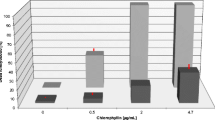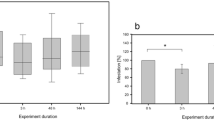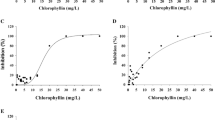Abstract
When used at low concentrations and added to the water body, water-soluble chlorophyllin (resulting from chlorophyll after removal of the phytol) and pheophorbid (produced from chlorophyllin by acidification) are able to kill mosquito larvae and other small animals within a few hours under exposure of solar radiation. Under laboratory conditions, the use of chlorophyllin/pheophorbid as photodynamic substances for pest control in water bodies promises to be not only effective and ecologically beneficial but also cheap. The LD50 (50% of mortality in the tested organisms) value in Culex sp. larvae was about 6.88 mg/l, in Chaoborus sp. larvae about 24.18 mg/l, and in Daphnia 0.55 mg/l. The LD50 values determined for pheophorbid were 8.44 mg/l in Culex, 1.05 mg/l in Chaoborus, and 0.45 mg/l in Daphnia, respectively. In some cases, chlorophyllin and pheophorbid were also found to be (less) active in darkness. The results presented in this paper show that chlorophyllin is about a factor of 100 more effective than methylene blue or hematoporphyrine, which were tested earlier for the same purpose. It is also much cheaper and, as a substance found in every green plant, it is 100% biodegradable.








Similar content being viewed by others
References
Abdel-Kader MH, El Sherbini AAM, El Tayeb TAA, Jori G, Rueck A (2008a) Sunlight and environmentally friendly sensitizer for mosquito control. in press
Abdel-Kader MH, El Sherbini EAM, El Tayeb TAA, Jori G, Ben Amor T (2008b) Environmentally friendly photopesticides. in press.
Brachs S, Haas W (2008) Swimming behavior of Schistosoma mansoni cercariae: responses to irradiance changes and skin attractants. Parasitol Res 102:685–690
Cox FEG (2002) History of human parasitology. Clin Microbiol Rev 15:595–612
El Tayeb TAA (2003) Laser scanning microscopy for determination of the efficiency of hematoporphyrin in control of Culex pipiens larvae and the snail vector of Fasciola gigantica. PhD thesis. National Institute of Laser Enhanced Sciences (NILES), Cairo University, pp 1–216
Engels D, Chitsulo L, Montresor A, Savioli L (2002) The global epidemiological situation of schistosomiasis and new approaches to control and research. Acta Tropica 82:139–146
Goklany IM (2004) Climate change and malaria. Science 306:55–56
Greenwood BM, Bojang K, Whitty CJM, Targett GAT (2005) Malaria. Lancet 365:1487–1498
Haas W, Haberl B, Hofmann M, Kerschensteiner S, Ketzer U (1998) Theronts of Ichthyophtirius multifiliis find their fish hosts with complex behavior patterns and in response to different chemical signals. Tokai J Exp Clin Med 23:329–331
Haas W, Grabe K, Geis C, Päch T, Stoll K, Fuchs M, Haberl B, Loy C (2002) Recognition and invasion of human skin by Schistosoma mansoni cercariae: the key-role of L-arginine. Parasitology 124:153–167
Haberl B, Kalbe M, Fuchs H, Ströbel M, Schmalfuss G, Haas W (1995) Schistosoma mansoni and S. haematobium: miracidial host-finding behavior is stimulated by macromolecules. Int J Parasitol 25:551–560
Haeberlein S, Haas W (2008) Chemical attractants of human skin for swimming Schistosoma mansoni cercariae. Parasitol Res 102:657–662
He Y-Y, Häder D-P (2002) Involvement of reactive oxygen species in the UV-B damage to the cyanobacterium Anabaena sp. J Photochem Photobiol B Biol 66:73–80
Kallert D, Eszterbauer E, El-Matbouli M, Erséus C, Haas W (2005) Life cycle studies of Myxobolus parviformis sp. n. (Myxozoa, Myxobolidae) from bream. Dis Aquat Org 66:233–243
Kallert D, Ponader S, Eszterbauer E, El-Matbouli M, Haas W (2007) Myxozoan transmission via actionospores: new insights in mechanisms and adaptations for host invasion. Parasitology 134:1741–1750
Kessel D, Smith K (1989) Photosensitization with derivatives of chlorophyll. Photochem Photobiol 49:157–160
Klisch M, Sinha RP, Richter PR, Häder D-P (2001) Mycosporine-like amino acids (MAAs) protect against UV-B-induced damage in Gyrodinium dorsum Kofoid. J Plant Physiol 158:1449–1454
Lee W-Y, Lim D-S, Ko S-H, Park Y-J, Ryu K-S, Ahn M-Y, Kim Y-R, Lee DW, Cho C-W (2004) Photoactivation of pheophorbid a induces a mitochondrial-mediated apoptosis in Jurkat leukaemia cells. J Photochem Photobiol B Biol 75:119–126
Millán de Kuhn R, Streb C, Breiter R, Richter P, Neeße T, Häder D-P (2006) Screening for unicellular algae as possible bioassay organisms for monitoring marine water samples. Water Res 40:2695–2703
Richter G (1996) Biochemie der Pflanzen. Thieme, Stuttgart, New York
Sachs J, Malaney P (2002) The economic and social burden of malaria. Nature 415:680–685
Tahedl H, Häder D-P (1999) Fast examination of water quality using the automatic biotest ECOTOX based on the movement behavior of a freshwater flagellate. Water Res 33:426–432
Tominaga H, Kodama S, Matsuda N, Suzuki K, Watanabe M (2004) Involvement of reactive oxygen species (ROS) in the induction of genetic instability by radiation. J Radiat Res 45:181–188
Trampuz A, Jereb M, Muzlovic I, Prabhu RM (2003) Clinical review: Severe malaria. Crit Care 7:315–323
WHO (2006) Schistosomiasis and soiltransmitted helminth infections—preliminary estimates of the number of children treated with albendazole or mebendazole. Weekly Epidemiol Rec 81(16):145–164
WHO (2007) Malaria. Fact sheet no. 94. Geneva, Switzerland
Willemann RL (2002) Development of an application of the ECOTOX system in the estuarine zone of the Baía da Babitonga, SC, Brazil, Diplom, Friedrich-Alexander Universität, Erlangen-Nürnberg, pp1–72
Acknowledgments
We gratefully acknowledge the friendly and competent support of Dr. Martin Oberle and his team, LfL Fischerei Höchstadt, who provided the carps and supported this work with valuable ideas and fruitful discussions. All performed experiments comply with the current laws in Germany.
Author information
Authors and Affiliations
Corresponding author
Rights and permissions
About this article
Cite this article
Wohllebe, S., Richter, R., Richter, P. et al. Photodynamic control of human pathogenic parasites in aquatic ecosystems using chlorophyllin and pheophorbid as photodynamic substances. Parasitol Res 104, 593–600 (2009). https://doi.org/10.1007/s00436-008-1235-6
Received:
Accepted:
Published:
Issue Date:
DOI: https://doi.org/10.1007/s00436-008-1235-6




